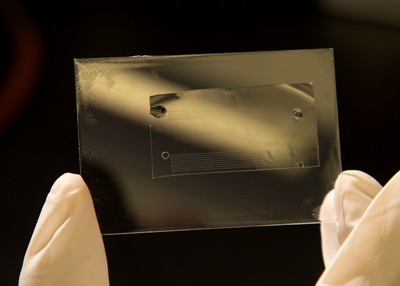Oct 29 2012
Chemists' innovation may be a better model for disease diagnostic kits

When someone develops liver cancer, the disease introduces a very subtle difference to their bloodstream, increasing the concentration of a particular molecule by just 10 parts per billion.
That small shift is difficult to detect without sophisticated lab equipment – but perhaps not for long. A new "lab on a chip" designed by Brigham Young University professor Adam Woolley and his students reveals the presence of ultra-low concentrations of a target molecule.
As the BYU researchers report in the journal Analytical Chemistry, their experiments detected as little as a single nanogram – one billionth of a gram – of the target molecule from a drop of liquid. And instead of sending the sample to a lab for chemical analysis, the chip allows them to measure with such precision using their own eyes.
"The nice thing about the system that we have developed is that this could be done anywhere," Woolley said. "Somebody could put the sample in, look at it, and have the result they need."
The trick is to line a tiny pipe with receptors that catch a specific molecule and allow others to pass by. When a drop of liquid is placed on the clear chip, capillary action draws the fluid through the channel, flowing up to one centimeter per second. As more of the target molecules are snagged by the receptors, the space constricts and eventually stops the flow.
How far the sample flows is a direct indication of the concentration of the target molecule (higher concentration = shorter distance, lower concentration = longer distance).
"The accuracy gained with this system should make it competitive with more expensive and complicated immunoassay systems," said Chuck Henry, a chemist at Colorado State University who was not affiliated with the project.
Woolley and his students hope their prototype will work as a blueprint for making inexpensive diagnostic tests for a variety of diseases and genetic disorders.
"There are a lot of molecules associated with diseases where concentrations around a nanogram per milliliter or less in blood are the difference between a disease state versus a healthy state," Woolley said.